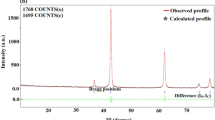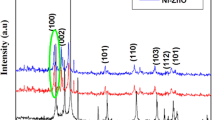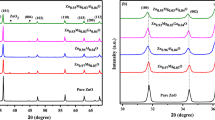Abstract
Magnesium-doped ZnO nanoparticles (Mg0.1Zn0.9O) were successfully synthesized following the solution combustion method. The effect of magnesium on the morphology, crystalline phases, and optical properties of the ZnO nanoparticles was studied. A relative band gap enhancement has been observed using the density functional theory (DFT) calculation through Mg doping from 3.19 eV to 3.24 eV. The photocatalytic degradation of 4-nitrophenol (4-NPh) has been investigated under UV irradiation in aqueous suspension where 1.5 g of Mg0.1Zn 0.9O/L removed 81% of 4-NPh (60 mg/L) under a pH solution of 12 within 120 min.
Graphical abstract








Similar content being viewed by others
Data availability
Data will be made available on request.
References
Benkhaya S, M’rabet S, El Harfi A (2020) A review on classifications, recent synthesis and applications of textile dyes. Inorg Chem Commun 115:107891. https://doi.org/10.1016/J.INOCHE.2020.107891
Gonçalves IMC, Gomes A, Brás R et al (2000) Biological treatment of effluent containing textile dyes. Color Technol 116:393–397. https://doi.org/10.1111/j.1478-4408.2000.tb00016.x
Chequer FMD, de Oliveira GAR, Ferraz ERA et al (2013) Textile dyes: dyeing process and environmental impact. Eco-Friendly Text Dye Finish. https://doi.org/10.5772/53659
El Hajam M, Kandri NI, Plavan GI et al (2020) Pb2+ ions adsorption onto raw and chemically activated dibetou sawdust: application of experimental designs. J King Saud Univ—Sci 32:2176–2189. https://doi.org/10.1016/J.JKSUS.2020.02.027
El Hajam M, Idrissi Kandri N, Harrach A et al (2019) Adsorption of Methylene Blue on industrial softwood waste “Cedar” and hardwood waste “Mahogany”: comparative study. Mater Today Proc 13:812–821. https://doi.org/10.1016/J.MATPR.2019.04.044
Gita S, Hussan A, Choudhury TG (2017) Impact of textile dyes waste on aquatic environments and its treatment. Environ Ecol 35:2349–2353
Dra A, Tanji K, Arrahli A et al (2020) Valorization of oued sebou natural sediments (Fez-Morocco area) as adsorbent of methylene blue dye : kinetic and thermodynamic study. Sci World J 2020:2187129. https://doi.org/10.1155/2020/2187129
Ghosh Ray S, Ghangrekar MM (2018) Comprehensive review on treatment of high-strength distillery wastewater in advanced physico-chemical and biological degradation pathways. Int J Environ Sci Technol 161(16):527–546. https://doi.org/10.1007/S13762-018-1786-8
Thiam A, Tanji K, Assila O et al (2020) Valorization of date pits as an effective biosorbent for remazol brilliant blue adsorption from aqueous solution. J Chem 2020:14. https://doi.org/10.1155/2020/4173152
Puvaneswari N, Muthukrishnan J, Gunasekaran P (2006) Toxicity assessment and microbial degradation of azo dyes. Indian J Exp Biol 44:618–626
Ejder-Korucu M, Gürses A, Dogar Ç et al (2015) Removal of organic dyes from industrial effluents: an overview of physical and biotechnological applications. Green Chem Dye Remov Waste Water Res Trends Appl. https://doi.org/10.1002/9781118721001.CH1
Balakrishnan A, Gaware GJ, Chinthala M (2023) Heterojunction photocatalysts for the removal of nitrophenol: a systematic review. Chemosphere 310:136853. https://doi.org/10.1016/J.CHEMOSPHERE.2022.136853
Xiong Z, Zhang H, Zhang W et al (2019) Removal of nitrophenols and their derivatives by chemical redox: a review. Chem Eng J 359:13–31. https://doi.org/10.1016/J.CEJ.2018.11.111
Raza W, Lee J, Raza N et al (2019) Removal of phenolic compounds from industrial waste water based on membrane-based technologies. J Ind Eng Chem 71:1–18. https://doi.org/10.1016/J.JIEC.2018.11.024
Bilal M, Bagheri AR, Bhatt P, Chen S (2021) Environmental occurrence, toxicity concerns, and remediation of recalcitrant nitroaromatic compounds. J Environ Manag 291:1685. https://doi.org/10.1016/J.JENVMAN.2021.112685
Djaballah AM, Bagtache R, Tartaya S, Trari M (2021) Synthesis and characterization of the semiconductor CuBi2O4 for optical and dielectric studies. Application to methyl violet degradation under visible light. React Kinet Mech Catal 134:1055–1067. https://doi.org/10.1007/S11144-021-02115-4/FIGURES/12
Bagtache R, Brahimi R, Abdmeziem K, Trari M (2021) Preparation and photo-electrochemical characterization of KAlPO4F: application to photodegradation of methyl violet under sunlight. React Kinet Mech Catal 133:1111–1120. https://doi.org/10.1007/S11144-021-02010-Y/FIGURES/8
Djaballah AM, Bagtache R, Benlambarek M, Trari M (2022) Semiconducting properties of CuBi2O4 prepared at low temperature: application to oxygen evolution under visible light. React Kinet Mech Catal 135:2769–2781. https://doi.org/10.1007/S11144-022-02260-4/FIGURES/10
El Mrabet I, Ihssane B, Valdés H, Zaitan H (2022) Optimization of Fenton process operating conditions for the treatment of the landfill leachate of Fez city (Morocco). Int J Environ Sci Technol 19:3323–3336. https://doi.org/10.1007/s13762-021-03393-0
Majdoub A, El Mrabet I, Majdoub M et al (2022) In situ deposition of Ag nanoparticles onto PE/rGO hybrids for the dip-catalytic hydrogenation of 4-nitrophenol into 4-aminophenol. Int J Environ Anal Chem. https://doi.org/10.1080/03067319.2022.2089034
El Hajam M, Kandri NI, Zerouale A et al (2022) Lignocellulosic nanocrystals from sawmill waste as biotemplates for free-surfactant synthesis of photocatalytically active porous silica. ACS Appl Mater Interfaces 14:19547–19560. https://doi.org/10.1021/acsami.2c02550
Zouheir M, Assila O, Tanji K et al (2021) Bandgap optimization of sol-gel-derived TiO2 and its effect on the photodegradation of formic acid. Nano Futur 5:025004
Fahoul Y, Zouheir M, Tanji K, Kherbeche A (2022) Synthesis of a novel ZnAl2O4/CuS nanocomposite and its characterization for photocatalytic degradation of acid red 1 under UV illumination. J Alloys Compd 889:161708. https://doi.org/10.1016/j.jallcom.2021.161708
Mahtab MS, Farooqi IH, Khursheed A (2022) Zero Fenton sludge discharge: a review on reuse approach during wastewater treatment by the advanced oxidation process. Int J Environ Sci Technol 19:2265–2278. https://doi.org/10.1007/S13762-020-03121-0/FIGURES/1
Belghiti M, Tanji K, El Mersly L et al (2022) Fast and non-selective photodegradation of basic yellow 28, malachite green, tetracycline, and sulfamethazine using a nanosized ZnO synthesized from zinc ore. React Kinet Mech Catal 135:2265–2278. https://doi.org/10.1007/s11144-022-02232-8
Tanji K, Navio JA, Martín-Gómez AN et al (2020) Role of Fe(III) in aqueous solution or deposited on ZnO surface in the photoassisted degradation of rhodamine B and caffeine. Chemosphere 241:125009. https://doi.org/10.1016/j.chemosphere.2019.125009
Tanji K, Zouheir M, Hachhach M et al (2021) Design and simulation of a photocatalysis reactor for rhodamine B degradation using cobalt-doped ZnO film. React Kinet Mech Catal 134:1017–1038. https://doi.org/10.1007/s11144-021-02116-3
Qi K, Yu J (2020) Modification of ZnO-based photocatalysts for enhanced photocatalytic activity. Interface Sci Technol 31:265–284. https://doi.org/10.1016/B978-0-08-102890-2.00008-7
Samadi M, Zirak M, Naseri A et al (2016) Recent progress on doped ZnO nanostructures for visible-light photocatalysis. Thin Solid Films 605:2–19. https://doi.org/10.1016/j.tsf.2015.12.064
Hamdy MS, Chandekar KV, Shkir M et al (2020) Novel Mg@ZnO nanoparticles synthesized by facile one-step combustion route for anti-microbial, cytotoxicity and photocatalysis applications. J Nanostructure Chem 11:147–163. https://doi.org/10.1007/s40097-020-00355-9
Zyoud AH, Zubi A, Zyoud SH et al (2019) Kaolin-supported ZnO nanoparticle catalysts in self-sensitized tetracycline photodegradation: zero-point charge and pH effects. Appl Clay Sci 182:1094. https://doi.org/10.1016/J.CLAY.2019.105294
Heo YW, Ivill MP, Ip K et al (2008) ZnO: growth, doping & processing. Mater Today 7:34–40. https://doi.org/10.1016/S1369-7021(04)00287-1
Patil KC, Aruna ST, Mimani T (2002) Combustion synthesis: an update. Curr Opin Solid State Mater Sci 6:507–512. https://doi.org/10.1016/S1359-0286(02)00123-7
Moore JJ, Feng HJ (1995) Combustion synthesis of advanced materials: part I. Reaction parameters. Prog Mater Sci 39:243–273. https://doi.org/10.1016/0079-6425(94)00011-5
Blaha P, Schwarz K, Madsen GKH, et al (2022) WIEN2K, an augmented plane wave plus local orbitals program for calculating crystal properties
Morgan WS, Jorgensen JJ, Hess BC, Hart GLW (2018) Efficiency of generalized regular k-point grids. Comput Mater Sci 153:424–430. https://doi.org/10.1016/j.commatsci.2018.06.031
Achouri F, Corbel S, Aboulaich A et al (2014) Aqueous synthesis and enhanced photocatalytic activity of ZnO/Fe2O3 heterostructures. J Phys Chem Solids 75:1081–1087. https://doi.org/10.1016/J.JPCS.2014.05.013
Moussa H, Girot E, Mozet K et al (2016) ZnO rods/reduced graphene oxide composites prepared via a solvothermal reaction for efficient sunlight-driven photocatalysis. Appl Catal B Environ 185:11–21. https://doi.org/10.1016/J.APCATB.2015.12.007
Sing KSW, Everett DH, Haul RAW et al (1985) Reporting physisorption data for gas/solid systems with special reference to the determination of surface area and porosity. Pure Appl Chem 57:603–619. https://doi.org/10.1351/pac198557040603
Etacheri V, Roshan R, Kumar V (2012) Mg-doped ZnO nanoparticles for efficient sunlight-driven photocatalysis. ACS Appl Mater Interfaces 4:2717–2725. https://doi.org/10.1021/AM300359H/SUPPL_FILE/AM300359H_SI_001.PDF
Zheng ALT, Abdullah CAC, Chung ELT, Andou Y (2022) Recent progress in visible light-doped ZnO photocatalyst for pollution control. Int J Environ Sci Technol. https://doi.org/10.1007/s13762-022-04354-x
Cen S, Lv X, Jiang Y et al (2020) Synthesis and structure of iron–copper/hollow magnetic/metal–organic framework/coordination sites in a heterogeneous catalyst for a Fenton-based reaction. Catal Sci Technol 10:6687–6693. https://doi.org/10.1039/D0CY01027H
Divband B, Jodaei A, Khatamian M (2019) Enhancement of photocatalytic degradation of 4-nitrophenol by integrating Ag nanoparticles with ZnO/HZSM-5 nanocomposite. Iran J Catal 9:63–70
Soussi A, Ait Hssi A, Boulkaddat L et al (2022) Structural, optical and electronic properties of La-doped ZnO thin films: experimental study and DFT calculations. Phys B Condens Matter 643:4181. https://doi.org/10.1016/J.PHYSB.2022.414181
Divband B, Khatamian M, Eslamian GRK, Darbandi M (2013) Synthesis of Ag/ZnO nanostructures by different methods and investigation of their photocatalytic efficiency for 4-nitrophenol degradation. Appl Surf Sci 284:80–86. https://doi.org/10.1016/J.APSUSC.2013.07.015
Noroozi Z, Ali Rasekh H, Jaafar Soltanianfard M (2019) Preparation and characterization of ZrO2-Cr2O3 nanocomposite as a p-n heterojunction by a facile sol-gel method: a kinetic investigation on the removal of p-nitrophenol dye from aqueous media. Polyhedron 168:11–20. https://doi.org/10.1016/J.POLY.2019.04.033
Zhang Y, Guo Y, Zhang G, Gao Y (2011) Stable TiO2/rectorite: preparation, characterization and photocatalytic activity. Appl Clay Sci 51:335–340. https://doi.org/10.1016/J.CLAY.2010.12.023
Zhang Y, Wang D, Zhang G (2011) Photocatalytic degradation of organic contaminants by TiO2/sepiolite composites prepared at low temperature. Chem Eng J 173:1–10. https://doi.org/10.1016/J.CEJ.2010.11.028
Khatamian M, Khandar AA, Divband B et al (2012) Heterogeneous photocatalytic degradation of 4-nitrophenol in aqueous suspension by Ln (La3+, Nd3+ or Sm3+) doped ZnO nanoparticles. J Mol Catal A Chem 365:120–127. https://doi.org/10.1016/J.MOLCATA.2012.08.018
Liu X, Zhao L, Lai H et al (2017) Efficient photocatalytic degradation of 4-nitrophenol over graphene modified TiO2. J Chem Technol Biotechnol 92:2417–2424. https://doi.org/10.1002/JCTB.5251
Devi LG, Anitha BG (2018) Exploration of vectorial charge transfer mechanism in TiO2/SrTiO3 composite under UV light illumination for the degradation of 4-nitrophenol: a comparative study with TiO2 and SrTiO3. Surf Interfaces 11:48–56. https://doi.org/10.1016/J.SURFIN.2018.02.005
Yadav V, Verma P, Sharma H et al (2020) Photodegradation of 4-nitrophenol over B-doped TiO2 nanostructure: effect of dopant concentration, kinetics, and mechanism. Environ Sci Pollut Res 27:10966–10980. https://doi.org/10.1007/S11356-019-06674-X
Ilyas H, Qazi IA, Asgar W et al (2011) Photocatalytic degradation of nitro and chlorophenols using doped and undoped titanium dioxide nanoparticles. J Nanomater. https://doi.org/10.1155/2011/589185
Li SX, Zheng FY, Liu XL et al (2005) Photocatalytic degradation of p-nitrophenol on nanometer size titanium dioxide surface modified with 5-sulfosalicylic acid. Chemosphere 61:589–594. https://doi.org/10.1016/J.CHEMOSPHERE.2005.02.054
Zhang Y, Gan H, Zhang G (2011) A novel mixed-phase TiO2/kaolinite composites and their photocatalytic activity for degradation of organic contaminants. Chem Eng J 172:936–943. https://doi.org/10.1016/J.CEJ.2011.07.005
Zheng P, Du Y, Chang PR, Ma X (2015) Amylose–halloysite–TiO2 composites: Preparation, characterization and photodegradation. Appl Surf Sci 329:256–261. https://doi.org/10.1016/J.APSUSC.2014.12.158
Acknowledgements
The Authors thank the innovation center at university Sidi Mohamed Ben Abdellah and the CNRST center for performing the characterization part.
Funding
This research has not received any specific grant from any funding agency in the public, commercial or not-for-profit sectors.
Author information
Authors and Affiliations
Contributions
KT: Conceptualization, Methodology, Writing—original draft. IEM: Visualization, Writing—review & editing. YF: Visualization, Writing—review & editing. AS: Writing—review & editing. MB: Writing—review & editing. IJ: Writing—review & editing. YN: Writing—review & editing. AEG: Writing—review & editing. AK: Resources, Supervision.
Corresponding author
Ethics declarations
Conflict of interest
The authors declare that they have no known competing financial interests or personal relationships that could have appeared to influence the work reported in this paper.
Additional information
Publisher's Note
Springer Nature remains neutral with regard to jurisdictional claims in published maps and institutional affiliations.
Supplementary Information
Below is the link to the electronic supplementary material.
Rights and permissions
Springer Nature or its licensor (e.g. a society or other partner) holds exclusive rights to this article under a publishing agreement with the author(s) or other rightsholder(s); author self-archiving of the accepted manuscript version of this article is solely governed by the terms of such publishing agreement and applicable law.
About this article
Cite this article
Tanji, K., El Mrabet, I., Fahoul, Y. et al. Experimental and theoretical investigation of enhancing the photocatalytic activity of Mg doped ZnO for nitrophenol degradation. Reac Kinet Mech Cat 136, 1125–1142 (2023). https://doi.org/10.1007/s11144-023-02385-0
Received:
Accepted:
Published:
Issue Date:
DOI: https://doi.org/10.1007/s11144-023-02385-0




